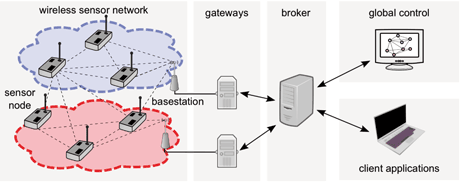This wireless sensor network (WSN) was motivated by the need for a manageable and scalable network constructed from relatively inexpensive off-the-shelf hardware. The WSN consumes very little power. The resultant network is in operation in several applications with up to 100 nodes. Simulations have shown excellent performance with 500 nodes. The network features centralized (rather than distributed) control; this aspect is the theme in this short paper.
Centralized rather than distributed control
It is an almost universal belief within the WSN community that centralized management of large networks has to be inefficient. We have encountered this statement in many publications - but without proof.
One of the main arguments quoted against centralized algorithms is that a global view of the network needs to be obtained before the network can perform its work. Collecting this information is considered to scale badly and to involve a substantial amount of communication and thus energy loss. Usually neglected is the fact that distributed algorithms initially require extra effort as well - and need time until they settle into a stable configuration. We argue that with an efficient topology-discovery mechanism the impact of establishing a global network is reduced far enough to make a centrally managed solution competitive.
Another argument for distributed algorithms is that they are more flexible in adapting to changes in the network topology, such as when nodes fail or link qualities change. Local decisions by the sensor nodes can quickly adapt and correct the problem, while loosing only little data. A centralized algorithm, however, can as well take care of such situations and instruct the network to act accordingly and in a coordinated fashion. Furthermore, having a single entity taking decisions improves the controllability and observability of the adaptation.

Figure 1: A centrally controlled wireless sensor network architecture. The architecture includes the wireless sensor network divided into clusters, each managed by a gateway, a broker to handle the communication between the gateways and the global control as well as to sensor applications.
In many cases it is also possible and even desirable to detect bad connectivity already at deployment time, such that appropriate physical changes can be made and the WSN does not have to cope with too many bad links at all. We believe that it is in general better to fix bad connectivity with physical modifications at deployment time than to try to capitalize on short-term improved link qualities.
It is also often argued that a centralized architecture introduces a single point of failure, namely the basestation controlling the whole network. In many cases, however, it is the basestation that receives all the data from the network, and if it fails, the WSN cannot export its data anyway; the WSN becomes useless. In a centrally controlled approach, sensor nodes may be able to detect this situation much faster than with a distributed protocol. The centralized control can then take appropriate measures such as going into a low-power waiting mode. If a distributed approach is badly designed, it may continue to run for a considerable amount of time while pointlessly wasting energy in trying to find working basestations.
Further advantages over distributed solutions:
- Simplicity of the code in the wireless nodes reduces cost and chances of malfunction.
- Needing to store little information in the nodes further reduces cost.
- Observability and controllability are enhanced by having all the information at a single point.
- Network management is eased in the sense that expert knowledge can be performed by the central control to optimize the operation of the network.
- Any sophisticated algorithm, even a distributed one, can be applied to determine the network configuration before deployment.
Additional features (covered in the referenced, more extensive report)
Taking advantage of the centralized control and adding to its effectiveness are a number of novel features, themselves novel contributions to the state-of-the-art. These include:
- an efficient algorithm for multi-hop network topology discovery and link quality estimation,
- a flexible TDMA superframe structure for supporting an ultra low power mode of operation,
- a combined clustering and routing algorithm for partitioning the complete WSN into multiple clusters with a-priori defined basestations, and
- a scheduling algorithm for multi-cluster and multi-channel data collection incorporating message aggregation.
Results for a 29-node field test are also included in the report.
Link:
http://ieeexplore.ieee.org/xpl/freeabs_all.jsp?arnumber=5984921
Please contact:
Hong Linh Truong,
IBM Zurich Research Laboratory, Switzerland
E-mail:










